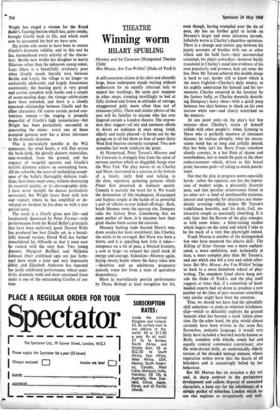Restoration drama
BALLET CLEMENT CRISP
Giselle's tragedy is not so much that she is betrayed, goes mad, dies, and then has to dance nightly in a damp forest; rather, it is that her story has become a vehicle for a ballerina—and a hearse for a touching dramatic masterpiece. One hundred and twenty-seven years of per- formance, of tinkering and editing, of ballerinas' egomania and audiences' taste for tulle and interminable balances on point, have reduced the ballet to a shadow of its former self.
To read Gautier's synopsis, and the remark- ably clear accounts of the original production, is to be made sadly aware of what has been lost: the dramatic logic, and the curious, in- definable quality that endowed this particular piece of romantic hokum with its extraordinary appeal, have been reduced to as formal and ineffectual a state as the conventional miming that is used to express them. In far too many productions the ballet has divided itself neatly in half, with a first act in which Giselle acted for all she was worth—finishing up very satis- fyingly with a mad-scene—and a second act in which the ballerina danced all out, leaving the drama with her peasant costume in the dressing room. In fact, the second act is as dramatic as the first: the Wilis are evil spirits, eager for vengeance on men, and the emotional crisis of the scene finds Giselle forced by Myrtha to lure Albrecht into dancing himself to death, although her love for him has survived ,the grave.
It is in the context of this kind of 'received' production, with all the drama in the pro- gramme's synopsis and none on stage, that Peter
Wright has staged a version for the Royal Ballet's Touring Section which has, quite simply, brought Giselle back to life, and which must now be accounted the best we have seen.
His prime aim seems to have been to restore Giselle's dramatic validity, and to this end he has reconsidered every activity of the charac- ters: Berthe now wishes her daughter to marry Hilarion rather than the unknown young suitor, Loys (there is a beautifully revelatory pose when Giselle stands literally torn between Berthe and Loys); the village is no longer an exclusively adolescent, and largely Amazonian community; the hunting party is very grand end arrives complete with hawks and a couple of scene-stealing dogs; the vintage celebrations have been extended, and there is a closely reasoned relationship between Giselle and the Oiher characters. Of course certain period con- ventions remain — the staging is properly tlespeotful of Giselle's high romanticism—but Wright has been particularly successful in renovating the mime: every one of those accepted gestures now has a direct relevance Ito the dramatic situation.
This is particularly notable in the Wili sequences; the wind howls, a wili flies across the back-cloth, the ghostly dancers materialise, mist-wreathed, from the ground, and the urgency of vengeful spectres and Giselle's terrible dilemma achieve an astonishing force. All the cobwebs, the years of unthinking accept- ance of the ballet's thoroughly dubious tradi- tions, have been swept away, without destroying its essential quality, or its choreographic style. I have never thought the dances particularly sacrosanct, but Wright treats them with love and respect; where he has amplified or de- veloped an incident he has done so with a nice period sense.
The result is a Giselle given new life—and handsomely decorated by Peter Farmer—with performances from the Royal Ballet's principals that have been uniformly good. Doreen Wells produced her best Giselle yet, in a beauti- fully danced version; David Wall has further consolidated his Albrecht so that it must now be ranked with the very best. Two young dancers, Margaret Barbieri and Nicholas
Johnson (their combined ages are just forty- . one) have made a joint and very impressive debut, and Elizabeth Anderton has repeated her justly celebrated performance, whose sensi- tivity, dramatic truth and sheer emotional force make it one of the outstanding Giselles of our time.







































 Previous page
Previous page